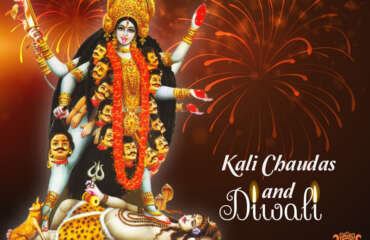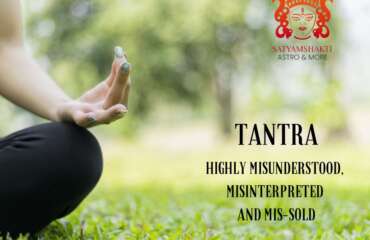Tantra and Yantra
Yantras in Hinduism (and also in Buddhism and Jainism) are instruments to aid in certain Tantrika spiritual practices. They take the form of geometrical diagrams. While mantras embody certain energy patterns of the macrocosm and microcosm in the form of sound, yantras likewise embody such patterns in the form of shape. Yantras are used in very similar contexts and applications as mantras (and usually they are used in conjunction): in the ritual worship of Devatas in temples and in devotees’ homes; in certain mystical meditation techniques; for protection from evil and harmful influences; as good luck charms; as preventative medicine; in occult/magical operations; in exorcism; in certain astrological applications; in Vastu Shastra; in numerology; and in various other sadhanas.
Yantras very often have mantras inscribed on them. Yantras may be etched or engraved in stone (often gemstones) or metal (usually copper or silver, or often gold-plated), or any flat surface. They also have three-dimensional forms, and indeed some tantrikas say that even a three-dimensional yantra is as limited a representation as two, for the yantras continue to expand into more and more dimensions, without limits. In some Hindu rites, especially magical rites, Yantras are traced on the ground or on paper, birch bark, wood, or cloth, and/or formed out of flowers, rice paste, ashes, or other such specific materials, and disposed of after the rite. Yantras are often drawn as rangoli designs during certain festivals. Yantras are also sometimes worn as talismans/amulets/charms, or even tattooed onto practitioners’ bodies. I have personally observed yantra talismans linked to specific deities to be in very wide, commonplace use in Sri Lanka, as well as parts of India. Yantra plates are often supposed to be kept in one’s home or workplace, facing a particular direction, given certain forms of worship and concentration at certain times, etc.
Some entire temples are built in the shape of giant yantras. Kamakhya is one.
Yantra Shastra, the occult science of yantras, is described in many scriptures of Hinduism, such as the Devi Bhagavata Purana, Naradiya Purana, Saundarya Lahari, many Tantra texts such as Gautamiya Tantra, Yogini Tantra, and hundreds of others, as well as in the Agamas. There are specific yantras for most Devatas in Hinduism – Ganesha, Kali, Shiva, Lakshmi, Krishna, Bhairavi, the Ashtamatrika Goddesses, Bagalamukhi, Kubera, Surya and all the Navagraha deities, Gayatri, Durga, Saraswati, Tara, Bhuvaneshwari, Chhinamasta, Dhumavati, Matangi, Hanuman, Rama, Matsya, Pratyangira, etc. Theoretically there is a yantra for every deity, though not all of them are known to humans.
Just like mantras, specific yantras literally embody specific Devatas in geometric form. While the mantra invokes the Devata when pronounced within the sadhaka’s consciousness, the yantra invokes the Devata when visualized within the sadhaka’s consciousness. As with mantras, the external form is but an outer representation, an aid to internal manifestation; it is the inner visualization, the shaping of one’s consciousness into the diagrammatic arrangement, that brings one in tune with the Devata. Often parts of the yantra also represent the Devata’s retinue of attendant deities, sub-deities, and powerful spirits, surrounding the main Devata who is concentrated in the Bindu point in the center of the yantra.
For yantra users who do not have such training of consciousness, external yantras may be consecrated and energized on certain days of the year by a Tantrika priest using the mantras that are the keys to that particular yantra, similar to the Prana Pratishta procedure for enlivening an idol.
Certain yantras are also used to make ritual foundations for certain objects to be placed on top of, like spiritual energetic charging ports. This is often done with lamps, vessels, etc. in Tantrik temples, or even with certain idols of Devatas that are set upon a yantra base. Such yantra bases beneath idols are usually completely covered up and hidden, even though they are often made of expensive materials like gold leaf. This usage is prescribed in Tantrik traditions such as Sri Vidya, for example.
Just as all mantras emanate from the primal Pranava sound, AUM, all yantras emanate from the central point, the Bindu, the nuclear Source from which the various geometric shapes radiate concentrically in all the directions, just as all of Creation emanates from a single point in Tantrika doctrine. While the whole yantra embodies the Devata, the Bindu is the main concentration of the Devata, who then spreads out throughout the cosmos to the four directions represented by the yantra’s border. Some yantra sadhanas follow a tracing path throughout the yantra, entering with certain mantrik passcodes through the outer gates and the stations of the various attendant deities, until one finally reaches the central Bindu and thus merges into the Absolute, thus attaining Enlightenment.
Stephen Knapp has written a beautiful description of yantras for Sanskriti magazine, which I will quote here:
“Everything that exists in the cosmos has some size and structure – perceivable or conceptualized – in subliminal, astronomical or intermediate dimensions. Even the invisible subtle entities have ‘shapes’ which could be ‘seen’ through mental eyes. The sagacious minds of the Vedic Age had deeper insight to ‘see’ the invisible or sublime elements of nature and express them in a universal language of symbols.
“They had thus invented a coding system of symbols, signs and alphabets (including digits) to represent the syllables of the seed mantras associated with the sublime fields of divine powers (devatas), natural tendencies of consciousness, emotional impulses in a being, etc; and the five basic elements (pancha-tatvas), their etheric vibrations and energy fields, and the states and motions of the enormous varieties of sub-atomic, atomic, and molecular structures generated thereby. Specific configurations of these codes were then incorporated in different yantras. Thus, by meditating on the yantras, and using particular mantras to invoke their potencies, would also awake higher powers within the mind and consciousness of the sadhaka, or practitioner, if done properly.”
Colors are not always used in yantras, but when used they are very specific and significant, not arbitrary or merely artistic. For example white, red, and black are traditionally used in many yantras to embody the gunas of sattwa, rajas, and tamas.
The most well-known Yantra in Hinduism is the Sri Yantra, employed in the ritual worship of the Goddess Shakti/Lalita Tripura Sundari. This Yantra is said to embody the totality of Existence and the user’s own unity with the cosmos.



